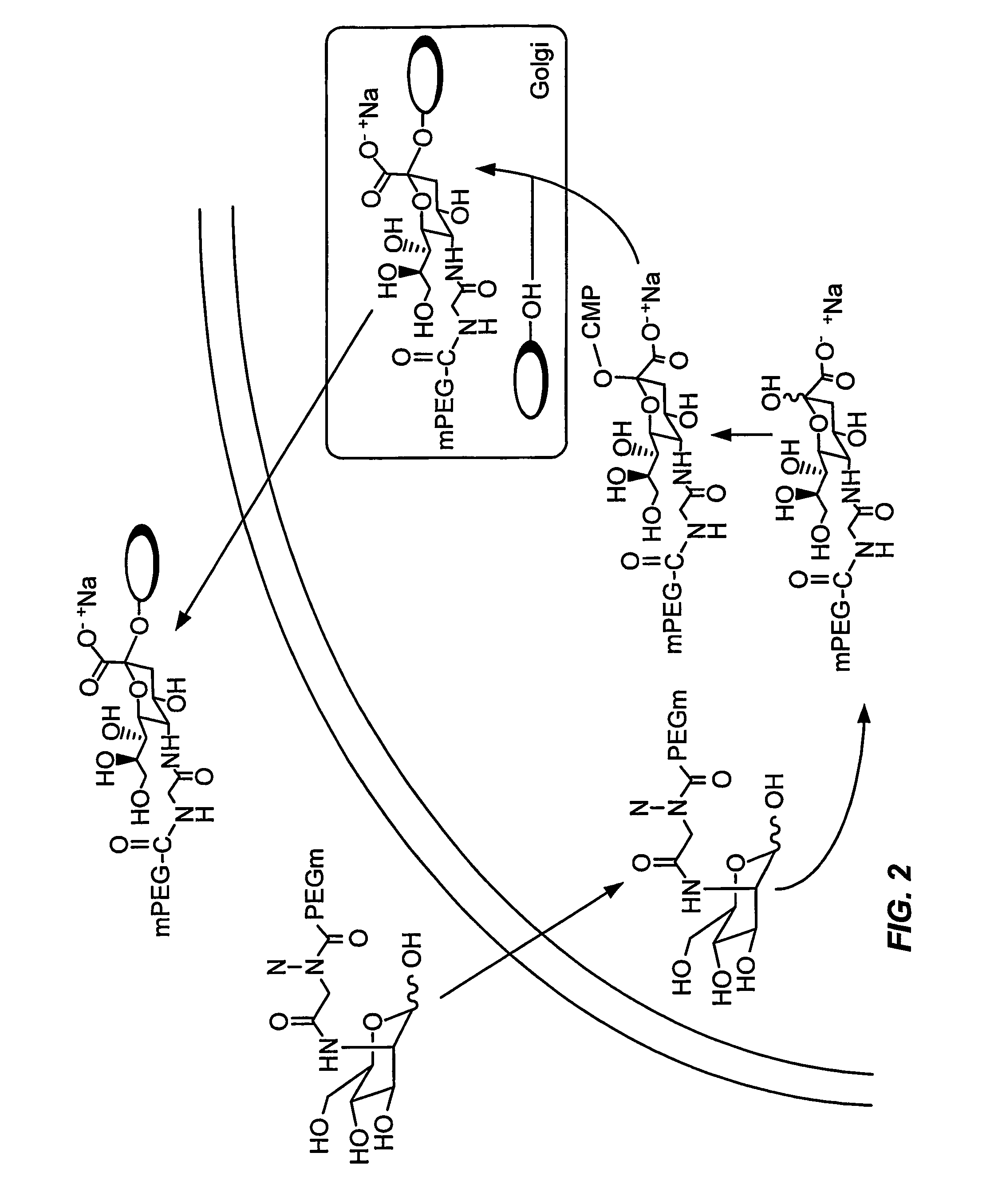Intracellular formation of peptide conjugates
a technology of conjugates and peptides, applied in the field of intracellular formation of peptide conjugates, can solve the problems of immunogenic nature, limited use of therapeutic peptides, enzymes used with unactivated glycosyl donors, etc., and achieve the effect of improving therapeutic or diagnostic properties
- Summary
- Abstract
- Description
- Claims
- Application Information
AI Technical Summary
Benefits of technology
Problems solved by technology
Method used
Image
Examples
example 1
[0417]Example 1 describes the formation of a peptide conjugate using a sialic acid modified with polyethylene glycol (FIG. 1).
[0418]Sialic acid-5-PEG is incubated with the cell under conditions in which the cell internalizes the sialic acid-5-PEG. The SA-5-PEG is intracellularly contacted with CMP-SA-synthetase and CTP to form the modified nucleotide sugar CMP-SA-5-PEG. The CMP-SA-5-PEG is then intracellularly contacted with a glycosylated secretory peptide and the appropriate sialyl transferase to form the secretory peptide conjugate peptide-SA-5-PEG. The peptide-SA-5-PEG is secreted into the extracellular space and isolated by standard methods.
example 2
[0419]Example 2 describes the formation of a peptide conjugate using a mannosamine modified with polyethylene glycol (FIG. 2).
[0420]Mannosamine-2-PEG is incubated with the cell under conditions in which the cell internalizes the mannosamine-2-PEG. The incubation was performed prior to induction of the glycosylated secretory peptide to allow the intracellular concentration of mannosamine-2-PEG to increase. The mannosamine-2-PEG is converted to the corresponding sialic acid-5-PEG with cellular enzymes. The sialic acid-5-PEG is intracellularly contacted with CMP-SA-synthetase and CTP to form the modified nucleotide sugar CMP-SA-5-PEG. The CMP-SA-5-PEG is then intracellularly contacted with a glycosylated secretory peptide and the appropriate sialyl transferase to form the secretory peptide conjugate peptide-SA-5-PEG. The peptide-SA-5-PEG is secreted into the extracellular space and isolated by standard methods.
example 3
[0421]Example 3 describes the formation of a peptide conjugate using a sialic acid modified with polyethylene glycol (FIG. 3).
[0422]Sialic acid-9-PEG is incubated with the cell under conditions in which the cell internalizes the sialic acid-9-PEG. The SA-9-PEG is intracellularly contacted with CMP-SA-synthetase and CTP to form the modified nucleotide sugar CMP-SA-9-PEG. The CMP-SA-9-PEG is then intracellularly contacted with a glycosylated secretory peptide and the appropriate sialyl transferase to form the secretory peptide conjugate peptide-SA-5-PEG. The peptide-SA-5-PEG is secreted into the extracellular space and isolated by standard methods.
PUM
| Property | Measurement | Unit |
|---|---|---|
| water-soluble | aaaaa | aaaaa |
| molecular weight distribution | aaaaa | aaaaa |
| soluble | aaaaa | aaaaa |
Abstract
Description
Claims
Application Information
 Login to View More
Login to View More - R&D
- Intellectual Property
- Life Sciences
- Materials
- Tech Scout
- Unparalleled Data Quality
- Higher Quality Content
- 60% Fewer Hallucinations
Browse by: Latest US Patents, China's latest patents, Technical Efficacy Thesaurus, Application Domain, Technology Topic, Popular Technical Reports.
© 2025 PatSnap. All rights reserved.Legal|Privacy policy|Modern Slavery Act Transparency Statement|Sitemap|About US| Contact US: help@patsnap.com



